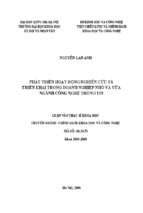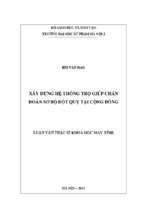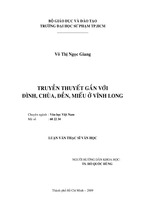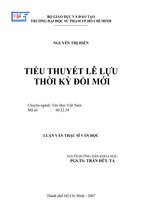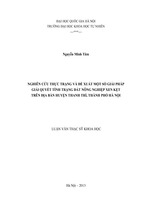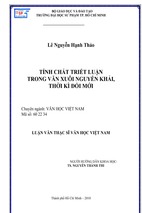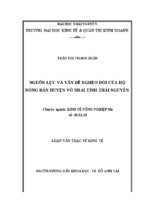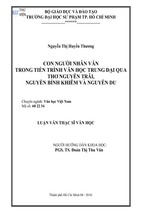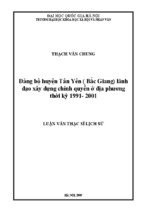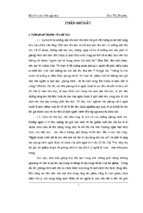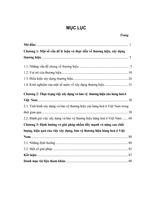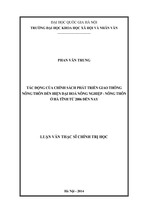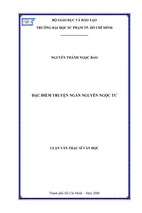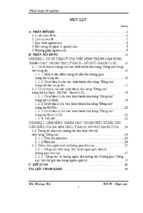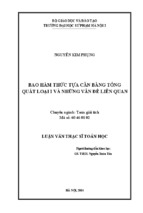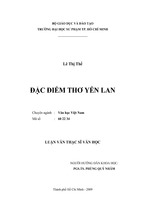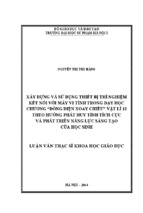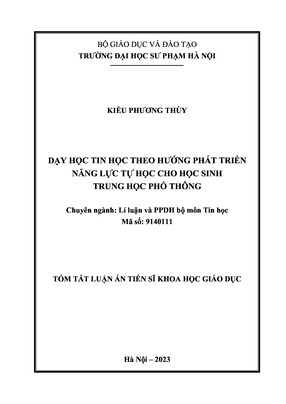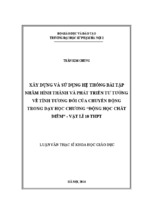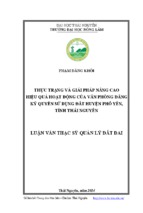This study was conducted in an attempt to explore the correlation between direct and indirect vocabulary learning strategies with the depth and breadth of vocabulary knowledge of English-specialized students at Le Hong Phong Gifted High School in Nam Dinh City. A total of 186 students completed a questionnaire concerning vocabulary learning strategy use. Subsequently, Vocabulary Levels Test (Schmitt et al., 2001) and Word Associates Test (Read, 1993; Read, 2004) were administered to measure the breadth and depth of lexical repertoire respectively. The results indicated that direct strategies were more frequently used by the students. Moreover, it was found that participants’ scores in strategy use correlated significantly and positively with breadth and depth of vocabulary knowledge. Indirect strategy use had a quite high correlation with two dimensions of vocabulary knowledge, implying that the students that had a large vocabulary size and a deep understanding of lexical repertoire tended to combine both direct and indirect strategies instead of using only one kind. Also, this highlights the importance of direct and indirect cognitive strategies, e.g., self-planning, self-monitoring, and self-evaluating. Relevant pedagogical implications were also discussed in the last chapter of this paper.
VIETNAM NATIONAL UNIVERSITY, HANOI
UNIVERSITY OF LANGUAGES AND INTERNATIONAL STUDIES
FACULTY OF ENGLISH LANGUAGE TEACHER EDUCATION
GRADUATION PAPER
THE CORRELATION BETWEEN VOCABULARY
LEARNING STRATEGIES AND VOCABULARY
KNOWLEDGE OF ENGLISH-SPECIALIZED STUDENTS
AT LE HONG PHONG GIFTED HIGH SCHOOL
Supervisor: Nguyen Huy Hoang, MA
Student: Tran Thi Bao Ngoc
Course: QH2015.F1.E4
HÀ NỘI – 2019
i
ĐẠI HỌC QUỐC GIA HÀ NỘI
TRƯỜNG ĐẠI HỌC NGOẠI NGỮ
KHOA SƯ PHẠM TIẾNG ANH
KHÓA LUẬN TỐT NGHIỆP
MỐI TƯƠNG QUAN GIỮA PHƯƠNG PHÁP HỌC TỪ VỰNG
VÀ KIẾN THỨC TỪ VỰNG CỦA HỌC SINH CHUYÊN ANH
TRƯỜNG THPT CHUYÊN LÊ HỒNG PHONG
Giáo viên hướng dẫn: Th.S Nguyễn Huy Hoàng
Sinh viên: Trần Thị Bảo Ngọc
Khóa: QH2015.F1.E4
HÀ NỘI – 2019
Declaration
I hereby state that I: Trần Thị Bảo Ngọc, class QH2015.F1.E4, being a
candidate for the degree of Bachelor of Arts (mainstream program) accept the
requirements of the College relating to the retention and use of Bachelor’s
Graduation Paper deposited in the library.
In terms of these conditions, I agree that the origin of my paper deposited in
the library should be accessible for the purposes of study and research, in accordance
with the normal conditions established by the librarian for the care, loan or
reproduction of the paper.
Trần Thị Bảo Ngọc
May 9, 2019
Supervisor’s signature of approval
Acknowledgements
Firstly, I would like to express my sincere thanks to my dear supervisor Mr. Nguyen
Huy Hoang, who is currently teaching in the Fast-track Division, Faculty of English
Language Teacher Education, ULIS, VNU. I am extremely thankful and indebted to
him for his relentless support, constructive feedbacks and invaluable suggestions that
have helped me in the completion of this paper. His devoted consultancy definitely
assisted us throughout the duration of my research.
Furthermore, I take this opportunity to express my humble gratitude to the assistance
of not only all of the English teachers at Le Hong Phong Gifted High School, who
helped me distribute the questionnaires and tests, but also the English-specialized
students who took part in completing my survey questionnaire and taking tests. Their
participation has played a crucial role in my research.
Last but not least, my sincere thanks go to my best friend, namely Tran Quang Dao,
for his sensible advice and continuously considerable encouragement. Without his
support, I could not have this research fully accomplished. Most significantly, I am
really grateful for my parents as well as my fiancé, whose love and care fueled me
with motivation to fulfill the research.
i
Abstract
This study was conducted in an attempt to explore the correlation between
direct and indirect vocabulary learning strategies with the depth and breadth of
vocabulary knowledge of English-specialized students at Le Hong Phong Gifted
High School in Nam Dinh City. A total of 186 students completed a questionnaire
concerning vocabulary learning strategy use. Subsequently, Vocabulary Levels Test
(Schmitt et al., 2001) and Word Associates Test (Read, 1993; Read, 2004) were
administered to measure the breadth and depth of lexical repertoire respectively. The
results indicated that direct strategies were more frequently used by the students.
Moreover, it was found that participants’ scores in strategy use correlated
significantly and positively with breadth and depth of vocabulary knowledge.
Indirect strategy use had a quite high correlation with two dimensions of vocabulary
knowledge, implying that the students that had a large vocabulary size and a deep
understanding of lexical repertoire tended to combine both direct and indirect
strategies instead of using only one kind. Also, this highlights the importance of
direct and indirect cognitive strategies, e.g., self-planning, self-monitoring, and selfevaluating. Relevant pedagogical implications were also discussed in the last chapter
of this paper.
Table of Contents
Acknowledgements ................................................................................................................i
Abstract .................................................................................................................................ii
List of figures .......................................................................................................................vi
List of tables ........................................................................................................................vii
CHAPTER 1: INTRODUCTION ......................................................................................... 1
1.1.
Background of the study .........................................................................................1
1.2.
Aims of the study and research questions ..............................................................3
1.3.
Research design ......................................................................................................4
1.4.
Scope of the study...................................................................................................4
1.5.
Significance of the study ........................................................................................5
1.6.
Thesis outline ..........................................................................................................5
CHAPTER 2: LITERATURE REVIEW .............................................................................. 6
2.1.
Vocabulary knowledge ...........................................................................................6
2.2.
Vocabulary learning strategies ...............................................................................9
2.2.1.
Direct strategies .............................................................................................10
2.2.2.
Indirect strategies ..........................................................................................10
2.3.
Previous research on vocabulary learning strategies ............................................11
2.4.
Previous research on vocabulary size ...................................................................12
2.5.
Previous research on vocabulary depth ................................................................14
2.6.
Previous research on the correlation between vocabulary learning strategies and
vocabulary knowledge .....................................................................................................15
CHAPTER 3: METHODOLOGY ...................................................................................... 17
3.1.
Research questions ...............................................................................................17
3.2.
Research methods .................................................................................................17
3.3.
Participants ...........................................................................................................18
3.4.1.
Questionnaire ................................................................................................18
3.4.2.
Vocabulary tests ............................................................................................19
3.4.2.1.
Vocabulary Levels Test .............................................................................19
3.4.2.2.
Word Associates Test ................................................................................20
3.5.
Data analysis .........................................................................................................21
3.6.
Data collection procedure .....................................................................................22
3.7.
Data analysis procedure ........................................................................................23
3.8.
Research ethics .....................................................................................................23
CHAPTER 4: FINDINGS ................................................................................................... 24
4.1.
The vocabulary learning strategies commonly used by English-specialized
students at Le Hong Phong Gifted High School ..............................................................24
4.1.1.
Direct Learning Strategies .............................................................................24
4.1.2.
Indirect Learning Strategies ..........................................................................25
4.2.
The correlation between vocabulary learning strategies and the breadth and depth
of vocabulary knowledge .................................................................................................26
4.2.1.
Vocabulary Levels Test score .......................................................................26
4.2.2.
Word Associates Test score ..........................................................................27
4.2.3. The correlation between strategies and vocabulary knowledge.........................28
4.2.3.1. The correlation between Direct learning strategies and vocabulary knowledge
......................................................................................................................................29
4.2.3.1.1. Direct learning strategies and the breadth of vocabulary knowledge ........29
4.2.3.1.2. Direct learning strategies and the depth of vocabulary knowledge ...........29
4.2.3.2. The correlation between Indirect learning strategies and vocabulary
knowledge ....................................................................................................................30
4.2.3.2.1. Indirect learning strategies and the breadth of vocabulary knowledge .....30
4.2.3.2.2. Indirect learning strategies and the depth of vocabulary knowledge ........31
4.3.
Discussion .............................................................................................................32
CHAPTER 5: CONCLUSION ............................................................................................ 35
5.1.
Summary of findings ............................................................................................35
5.2.
Pedagogical implications ......................................................................................35
5.3.
Limitations and suggestions for future research ...................................................37
5.4.
Conclusion ............................................................................................................37
References ........................................................................................................................... 39
Appendices .......................................................................................................................... 42
Appendix A......................................................................................................................42
Appendix B ......................................................................................................................46
Appendix C ......................................................................................................................54
List of figures
Figure 2.1 The Lexical Space (Daller et al., 2007, p.8) ............................................ 8
List of tables
Table 2.1 “What Is Involved in Knowing a Word” (Nation, 2009, p.27) ................. 7
Table 3.1 Items in the Questionnaire....................................................................... 19
Table 4.1 Average DLS Usage of English-specialized Classes ............................... 25
Table 4.2 Average ILS Usage of English-specialized Classes ................................ 26
Table 4.3 VLT Score among Classes ....................................................................... 26
Table 4.4 WAT Score of Students ............................................................................ 27
Table 4.5 Spearman’s Rank Correlation Test between DLS and the Breadth of
Vocabulary Knowledge ............................................................................................ 29
Table 4.6 Spearman’s Rank Correlation Test between DLS and the Depth of
Vocabulary Knowledge ............................................................................................ 29
Table 4.7 Spearman’s Rank Correlation Test between ILS and the Breadth of
Vocabulary Knowledge ............................................................................................ 30
Table 4.8 Spearman’s Rank Correlation Test Between ILS and the Depth of
Vocabulary Knowledge ............................................................................................ 31
List of abbreviations
EFL
English as a Foreign Language
ELT
English Language Teaching
ESL
English as a Second Language
IELTS
The International English Language Testing System
GMAT
Graduate Management Admission Test
LA
Learner autonomy
TOEFL
Test of English as a Foreign Language
VLT
Vocabulary Levels Test
WAT
Word Associates Test
ii
CHAPTER 1: INTRODUCTION
This chapter explicates the problem statements and rationales for this study.
It then presents the research questions which this study sought to address and
highlights the significance and the scope of this study. The chapter ends with an
outline of the organization of the whole thesis.
1.1.
Background of the study
It is widely acknowledged that vocabulary plays an integral role in language
acquisition since language comprehension or production heavily depends on the
command of vocabulary knowledge (Fan, 2003). According to Fan (2003),
vocabulary knowledge is the biggest part of learning a language and the lack of
vocabulary knowledge can have a tremendous effect on the mastery of all the four
skills. To be more precise, learners need sufficient knowledge of lexical items prior
to being able to comprehend the language input or produce output (Teng, 2014a).
There is convincing evidence that a good knowledge of grammar alone is not enough,
but vocabulary is crucial for communication in second and foreign language apart
from grammar. In many cases, learners might produce grammatically incorrect
sentences, which may still be understood if appropriate words are used. Furthermore,
not only is vocabulary knowledge dispensable for communication, but for academic
study as well. In reality, a number of standardized academic tests such as
International English Language Testing System (IELTS), Test of English as a
Foreign Language (TOEFL), Graduate Management Admission Test (GMAT),
Scholastic Assessment Test (SAT) require learners to acquire a rich English
vocabulary. Therefore, it is crucial that learners give high priority to learning and
developing their vocabulary knowledge. Unfortunately, language learners
themselves admit experiencing a considerable lack of adequate vocabulary
knowledge, and most learners consider the acquisition of vocabulary their greatest
obstacle in language mastery (Meara, 1980).
In the past, not much attention was paid to vocabulary learning (Milton, 2009).
Vocabulary learning was neglected, and research on vocabulary acquisition was
minimal compared to that on other areas such as syntax or phonology (Meara, 1980).
1
According to Milton (2009), one of the important reasons for this was that the
Grammar-translation method (GTM), the most dominant English teaching method in
the 20th century, focused on the role of language rules and grammatical structures
with the thought that vocabulary knowledge merely played a secondary role in
mastering a foreign language. Fortunately, the importance of vocabulary in learning
a language is now being acknowledged by not only linguistics but language learners
as well. Over the past few decades, there has been evidence of the shift in the great
emphasis from teachers and teaching to learners and learning (Nation, 1990). A
number of books by Oxford (1990), Numan (1991), Nation (1990) also illustrate the
importance of learning strategies other than teaching methodologies in foreign
language acquisition, which can help develop students’ self-autonomy, hence the
more effective learning process. Not only books on learning strategies in general, but
those on vocabulary learning strategies introduced by Nation (1990), Nation (2001),
Taylor (1990) also can support the linguistic experts’ tendency of paying attention to
learners’ vocabulary learning strategies.
As a matter of fact, it is the significance of vocabulary in learning and
mastering a language that has inspired linguists to conduct both qualitative and
quantitative research on the vocabulary knowledge of language learners in order to
gain information about what sort of and how much knowledge they have about
words. After that, linguistics would think of ways to reinforce their learning of those
aspects. Research findings are supposed to assist linguists as well as teachers and
even language learners in the development of suitable materials and methods for
promoting learners' vocabulary knowledge. Due to the importance of the subject, a
number of studies on second and foreign language learners' vocabulary knowledge
have been conducted in many countries in the world. In the Vietnamese context,
despite the existence of many previous studies that have emphasized in discovering
students’ vocabulary learning strategies, very little in-depth research has been done
on Vietnamese learners' vocabulary knowledge as far as the size and depth of
vocabulary knowledge are concerned as well as research assessing the relationship
between these strategies and vocabulary knowledge. Moreover, most linguists and
2
teachers have focused on vocabulary knowledge of university students but not paying
attention to that of high-school ones. Thus, information about the vocabulary
knowledge of the high-school students is therefore desperately needed.
As a former student at English class at Le Hong Phong Gifted High School as
well as a senior majoring in English teaching, I have received many questions
relating to vocabulary learning which are raised by my old friends from the high
school as well as among my current friends at my university. Personally, I am
conscious of the importance of doing research on English vocabulary learning
strategies in general and the correlation between these strategies and vocabulary
knowledge in particular. The above reasons are the motivation and driving force for
me to conduct this research. The present study attempted to fill at least a part of the
void in this field of research. To be more specific, the study measured the size of
their vocabulary, or how many words the learners know, and their vocabulary depth,
i.e. what they know about the words. Nevertheless, this study focused merely on the
receptive sides of these two aspects of vocabulary knowledge, which means that just
the learners' ability to recognize words was being assessed whereas their ability to
produce written or spoken words was left aside.
1.2.
Aims of the study and research questions
This aim of the research was to explore what strategies were commonly used by
students in learning English vocabulary, and to determine whether or not there was a
correlation between the strategies and the vocabulary knowledge of English-specialized
students at Le Hong Phong Gifted High School. After that, several pedagogical
implications based on the collected findings were provided in order to help improving
the quality of English learning in general and English vocabulary learning in particular
of not only English-specialized students at Le Hong Phong Gifted High School, but all
English learners also.
In order to accomplish these objectives, the study was set out to seek answers to
the following research questions:
3
i.
What vocabulary learning strategies do English-specialized students at Le
Hong Phong Gifted High School commonly use?
ii.
What is the correlation between their vocabulary learning strategies and
the breadth and depth of vocabulary knowledge?
1.3.
Research design
The present study is quantitative in nature: the questionnaires with the Likert
scale was used to discover what vocabulary learning strategies were adopted by the
students, and the tests were used to assess vocabulary knowledge give scores in
numbers; thus, all of the results are represented and compared numerically with the
use of statistical software SPSS. The data was gathered using a questionnaire and
two vocabulary tests, that were, the Vocabulary Levels Test (VLT), which measured
size of vocabulary, and the Word Associates Test (WAT), which assessed depth of
vocabulary knowledge. The participants were informed about the aim of the present
study and made clear that the test did not affect their grades or course evaluation.
Before taking the tests, the participants were given instructions on how they should
complete the tests. The participants were asked to provide their personal information
such as name and class so that the efficiency of the correlation could be assured.
After that, the collected data was analyzed with the use of the statistical software
SPSS.
1.4.
Scope of the study
The topic of this study is the correlation between vocabulary learning strategies
and vocabulary knowledge that is supposed to include both receptive and productive
vocabulary knowledge. Due to the time and the length of the study, it is just limited to
receptive vocabulary knowledge that is assessed by two vocabulary tests. In addition,
the participants of the study are also limited to merely English-specialized students at
Le Hong Phong Gifted High School, Nam Dinh City. Therefore, this research is
designed to investigate vocabulary learning strategies employed by 210 Englishspecialized students at six classes ranging from grade 10 to 12 at Le Hong Phong Gifted
High School, after that, the correlation between these strategies and learners’
vocabulary knowledge will be analyzed.
4
1.5.
Significance of the study
The experience of reviewing the use of vocabulary learning strategies and
checking level of vocabulary knowledge can bring numerous benefits to both students
and teachers as a chance for them to reflect on their learning and teaching themselves.
In addition, the findings of this study are expected to provide insights into the
correlation between the vocabulary learning strategies and vocabulary knowledge;
therefore, the most effective strategies can be determined with a view to contributing to
the improvement of English teaching in general and the teaching of English vocabulary
in particular. After that, the English teachers at Le Hong Phong Gifted High School that
apply the recommended approaches derived from the findings of the study will be able
to improve the quality of English learning among the students.
1.6.
Thesis outline
The thesis is divided into five chapters:
Chapter 1 includes the rationale, the subjective, the research questions, the
scope, the method and the design of the study.
Chapter 2 is an insight of the literature review that are relevant to vocabulary
learning strategies research, some basic concepts related to learning strategies,
vocabulary learning and vocabulary knowledge. In addition, vocabulary learning
strategy classification is also reviewed to set up the theoretical framework for the
investigation in the next chapter.
In Chapter 3, the research design is presented, including the context of the
study, the research questions, the research methodologies, the participants and the
findings of the study.
Chapter 4 discusses the use of vocabulary learning strategies as well as the
correlation between these strategies and vocabulary knowledge of Englishspecialized students at Le Phong Gifted High School.
Chaper 5, the last chapter, includes some conclusions and some limitations
of the study as well as several pedagogical implications for the further improvement
in the quality of students’ vocabulary learning.
5
CHAPTER 2: LITERATURE REVIEW
This chapter first reviews related studies about learner autonomy, vocabulary
knowledge in terms of the breadth and depth, and vocabulary learning strategies
including direct and indirect strategies. Then, it goes on to describe the findings from
previous studies that investigated the correlation between the use of vocabulary
learning strategies and vocabulary knowledge in the context of EFL learning.
2.1.
Vocabulary knowledge
To begin with, vocabulary knowledge can be divided into receptive and
productive knowledge. Receptive knowledge refers to the learner’s ability to deal
with words and recognize them in the context of reading or listening, whereas
productive knowledge is the ability to recall words in 12 speaking or writing.
Nevertheless, the relationship between the two types of knowledge is unobvious,
which could be due to variance in learners’ vocabulary skills and a wide range of
kinds of tests used to assess the knowledges (Daller et al., 2007). Milton (2009) notes
that receptive and productive knowledge are not so clearly distinct because when one
reads or listens, he also actively anticipates certain words to come next. In fact, the
division of receptive and productive vocabulary tends to be commonly used to
describe word knowledge in vocabulary studies since it is easy to discuss and
measure receptive and productive knowledge as two separate items.
Nation (2009, p.27) demonstrates the separation of receptive and productive
vocabulary knowledge in his table What is involved in knowing a word, where he
splits word knowledge into several different sections.
There are three main categories, namely Form, Meaning and Use, which all
have been divided into three subcategories. Then, each subcategory has been split
into receptive and productive knowledge. Daller et al. (2007, p.4) find Nation's list
the “most comprehensive incarnation” of word knowledge so far and many other
researchers (e.g., Greidanus and Nienhuis, 2001; Milton, 2009; Li and Kirby, 2012)
have taken the advantage of it. The model recognizes that a learner does not have to
6
know all the aspects to have knowledge of a word, but it seems to ignore the
possibility that a learner might have partial knowledge of some aspects.
Table 2.1
“What Is Involved in Knowing a Word” (Nation, 2009, p.27)
Form
Spoken
Written
Word parts
Meaning Form and
meaning
R
What does the word sound like?
P
How is the word pronounced?
R
What does the word look like?
P
How is the word written and spelled?
R
What parts are recognizable in this word?
P
What word parts are needed to express the meaning?
R
What meaning does this word form signal?
P
What word form can be used to express this
meaning?
Use
Concept and
R
What is included in the concept?
referents
P
What items can the concept refer to?
Associations
R
What other words does this make us think of?
P
What other words could we use instead of this one?
Grammatical
R
In what patterns does the word occur?
functions
P
In what patterns must we use this word?
Collocations
R
What words or types of words occur with this one?
P
What words or types of words must we use with this
one?
Constrains
R
on use
(register,
Where, when, and how often would we expect to
meet this word?
P
Where, when, and how often can we use this word?
frequency…)
Note: In column 3, R = receptive knowledge, P = productive knowledge
Furthermore, another model of vocabulary knowledge was presented by
Daller et al. (2007, p.8) named as the lexical space.
7
Figure 2.1 The Lexical Space (Daller et al., 2007, p.8)
The lexical space has three dimensions, which describe different aspects of
learners' vocabulary knowledge, namely breadth, depth and fluency. The first
dimension, breadth, which is also called size, includes the form category and the subcategory form and meaning of Nation's list. The second one, depth, consists of the
sub-categories concepts and referents, associations, grammatical functions,
collocations and constraints on use. The third dimension is fluency, which refers to
the capability to recall and use words automatically and accurately. Thus, it is
suggested that a learner be located somewhere within the lexical space depending on
the size of their vocabulary, their knowledge of words and the ease to recall and use
those words (Daller et al., 2007).
However, according to McCarthy (1992), vocabulary knowledge includes
merely two dimensions instead of three, namely breadth of vocabulary knowledge
and depth of vocabulary knowledge. Firstly, the breadth of vocabulary knowledge
refers to the vocabulary size or the quantity of words known by a learner at a certain
level (Nation, 2001). Secondly, the depth of vocabulary knowledge is regarded as
the quality of the awareness of words, which means that not only should learners be
conscious of the meaning and form of a word, but they also should understand its
deeper aspects such as pronunciation, spelling, register, frequency, morphology,
8
syntactic and collocational prosperities (Qian, 2002), then they are able to apply it
into the appropriate situations.
To sum up, there has not been an exact definition of vocabulary knowledge,
but it has several ideals in common. First, knowing a word involves not only the
awareness of its spelling, morphology, pronunciation, and meaning or the equivalent
of the word in the mother tongue, but also knowing other aspects such as its
collocations, part of speech, frequency or register (Nation, 1990 & Taylor, 1990).
Second, “learning burden” of a word is considered as the amount of effort made by
a learner in learning the word (Nation, 2000). According to him, “different words
have different learning burdens for learners with different backgrounds and each of
the aspects of what it means to know a word can contribute to its learning burden”
(p. 23). Thus, when learning the vocabulary in the second language, it is crucial to
educate students with vocabulary learning strategies. However, it is possible for
teachers to help decrease students’ learning burdens by providing them with several
organized vocabulary learning strategies. Taking the importance of vocabulary
knowledge to the development of the general language proficiency into
consideration, seeking for ways to improve learners’ vocabulary knowledge is
worthwhile.
2.2.
Vocabulary learning strategies
“Vocabulary learning strategies are specific behavioral or mental actions
taken by learners to make their vocabulary learning easier, faster, more enjoyable,
more self-directed, more effective, and more transferable to new situations.”
(Oxford, 1990, p. 8). Vocabulary learning strategies are steps applied by learners to
acquire new lexical items in the target language. A number of classifications of
different vocabulary learning strategies are proposed by different researchers
(Oxford, 1990; Stoffer, 1995; Schmitt, 1997; Nation, 2001; and Gu, 2003). While a
wide variety of definitions of the vocabulary learning strategies have been suggested,
this study has adopted the definition demonstrated by Oxford (1990), who
categorized them into two main groups.
9
- Xem thêm -

